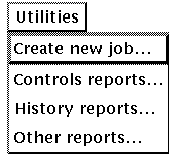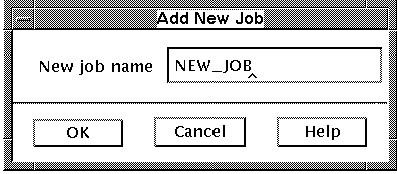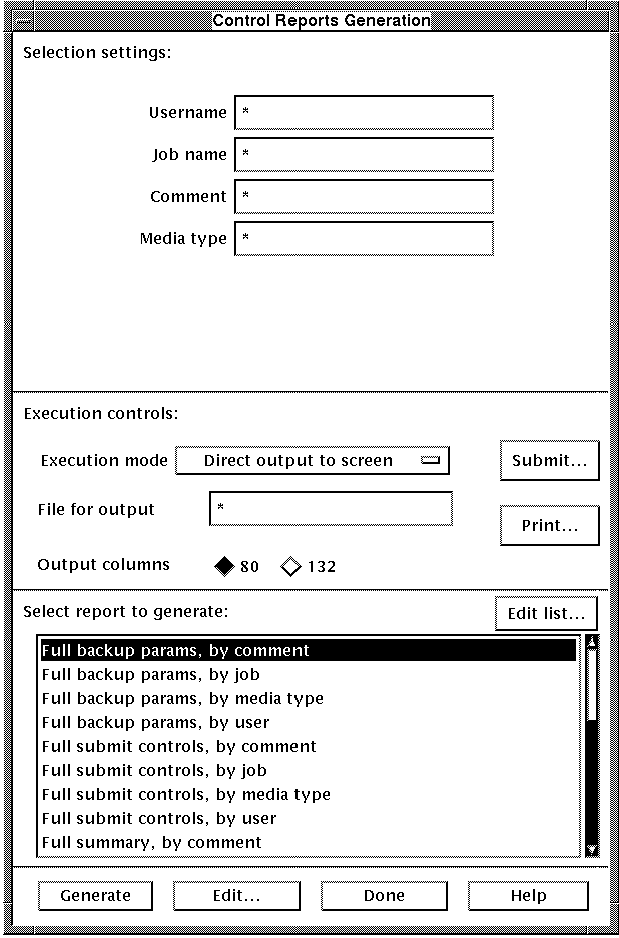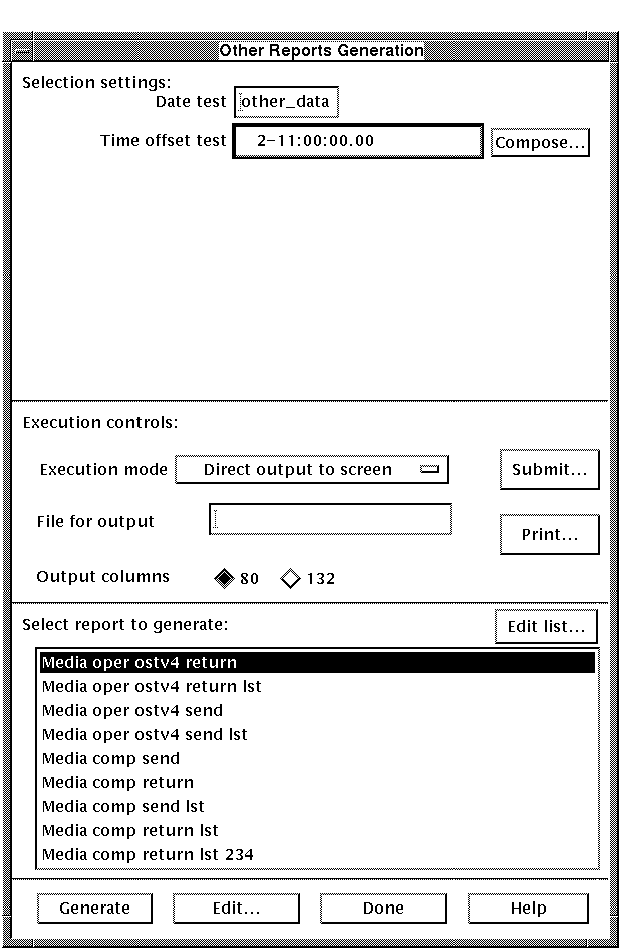| Previous | Contents | Index |
The Utilities menu is used to perform several BCKMGR tasks including creating a new job, performing a full disk recovery, restoring via search and report functions. These utility functions are described in the following section.

The process of creating a new backup job is to first name the job and to then define the controls data for the job as described in Section 4.4.1, Display controls.../Modify controls.... To create a new backup job, select Create a new job... from the Utilities menu. Fill in the name of the new job and left-click the [OK] button.

The Controls data dialog box can then be used to fill
in all attributes of the new job.
5.7.2 Control reports
BCKMGR control reports are reports that provide information about the BCKMGR database. The Control reports menu selection is used to produce a wide variety of control reports that can be printed to a printer or file or output to the screen in a window. Reports can be customized to include certain data or produced using the default data.
In order to produce control reports, select Control reports from the Utilities menu.

The top section of the dialog box is used to set the selection settings for the report. The data entered into each field in this form can be used as a selection filter to control which media are to be displayed in the reports. The fields may be filled in as follows:
| Field | Description |
|---|---|
| Username | Username assigned to the job. |
| Job name | Name of the job. |
| Comment | A text field into which any related text data may be inserted |
| Media type | Type of media included in the backup report. |
In the middle section of the dialog box are the Execution controls for the report. This is where you designate how the report is to be displayed or printed, how wide the report will be and the submit and print controls. The Execution mode may be selected from the drop down menu as shown in Table 5-5.
| Field | Description |
|---|---|
| Batch output to file | The report is output to a batch queue which then outputs it to a file. |
| Batch output to print queue | The report is output to a batch queue which then outputs it to a printer. |
| Direct output to file | The report is directly output to a file. |
| Direct output to print queue | The report is directly output to a print queue. |
| Direct output to screen | The report is directly output to the screen. |
The File for output is the file the report will be output to if the execution mode designates that the report is output to a file. The Output columns radio buttons are used to designate whether the report will have 80 or 132 columns.
The [Submit...] button allows the user to set the parameters used when submitting a report. The fields in the Submit parameters dialog box are explained in Table 5-6.
| Field | Description |
|---|---|
| Log file name | This specifies where to place the report log file that is created during report generation. Any file name that is provided is parsed and a default of "SYS$SYSLOGIN:report_name.LOG" is used to complete any missing elements. |
| Job name in queue | This defines the job name that is to be assigned this report generation job when it is in the batch execution queue. This name will only appear when you use the VMS command SHOW ENTRY or SHOW QUEUE. By default, this name is the same as the job entry in the MEDIA database. |
| Queue characteristic | This is a single known characteristic name that is to be associated with the job when it is submitted. Characteristics are arbitrary attributes that can be assigned to job queues. A job will only execute in a queue with matching characteristics. |
| Batch queue name | This defines what batch queue the report generation job is to be placed in for execution. This can be either a generic or node specific execution queue. The default, if none has been defined either implicitly or explicitly, is SYS$BATCH. |
| Submit after | This is the time when the job, pending in the submit queue, will be executed. |
| Queue priority | This specifies what queue priority to assign this job when it is inserted into the batch queue for execution. A non-privileged user is limited to a maximum value that is controlled by the AUTHORIZE program and/or the SYSGEN parameter MAXQUEPRI. The priority is NOT the execution priority but strictly the priority used to order jobs in the batch execution queue while they are waiting to start. |
| Action flags |
The following flags are set to perform the specified actions:
|
| Working set values | The three working set entries shown on the form provide for limitations on the batch job use of system resources. |
The [Print...] button allows the user to set the parameters used when printing a report. The fields in the Print parameters dialog box are explained in Table 4-1.
The bottom section of the dialog box is used to select the report to be submitted. The report list may also be edited by left-clicking on the [Edit list...] button.
The report definition may be edited by left-clicking on the
[Edit...] button. When all options are set correctly,
left-click on the [Generate] button to submit and output the
report.
5.7.3 History reports
BCKMGR history reports are reports that provide information about BCKMGR history. The History reports menu selection is used to produce a wide variety of history reports that can be printed to a printer or file or output to the screen in a window. Reports can be customized to include certain data or produced using the default data.
In order to produce control reports, select History reports from the Utilities menu.

The top section of the dialog box is used to set the Selection settings for the report. The data entered into each field in this form can be used as a selection filter to control which media are to be displayed in the reports. The fields may be filled in as follows:
| Field | Description |
|---|---|
| Job name | The name of the job that is the unique identifier. |
| Disk volume | Name of the volume set that the job uses. |
| Save set | Save set associated with the job. |
| Volume set | Volume set the job belongs to. |
| From log date | Earliest log date to place in the report. |
| To log date | Latest log date to place in the report. |
| Medium id | Identifier of the medium associated with the job. |
| Backup type | Backup type of the history report data. |
| Recovery | Determines whether recovery option is set. |
The middle section of the dialog box are the Execution controls for the report. This is where you designate how the report is to be displayed or printed, how wide the report will be and the submit and print controls. The Execution mode may be selected from the drop down menu as described in Table 4-12.
The File for output is the file the report will be output to if the execution mode designates that the report is output to a file. The Output columns radio buttons are used to designate whether the report will have 80 or 132 columns.
The [Submit...] button allows the user to set the parameters used when submitting a report. The fields in the Submit parameters dialog box are explained in Table 5-6.
The [Print...] button allows the user to set the parameters used when printing a report. The fields in the Print parameters dialog box are explained in Table 4-1.
The bottom section of the dialog box is used to select the report to be submitted. The report list may also be edited by left-clicking on the [Edit list...] button.
The report definition may be edited by left-clicking on the
[Edit...] button. When all options are set correctly,
left-click on the [Generate] button to submit and output the
report.
5.7.4 Other reports...
The Other reports... selection is used to create reports that have customized selection settings which were set up in the Other reports... section of the Control menu. See Section 5.5.5 for instructions on setting up these selection settings.
The middle section of the dialog box is where the Execution controls for the report are. This is where you designate how the report is to be displayed or printed, how wide the report will be and the submit and print controls. The Execution mode may be selected from the drop down menu as described in Table 5-5.

The File for output is the file the report will be output to if the execution mode designates that the report is output to a file. The Output columns radio buttons are used to designate whether the report will have 80 or 132 columns.
The [Submit...] button allows the user to set the parameters used when submitting a report. The fields in the Submit parameters dialog box are explained in Table 5-6.
The [Print...] button allows the user to set the parameters used when printing a report. The fields in the Print parameters dialog box are explained in Table 4-1.
The bottom section of the dialog box is used to select the report to be submitted. The report list may also be edited by left-clicking on the [Edit list...] button.
The report definition may be edited by left-clicking on the [Edit...] button. When all options are set correctly, left-click on the [Generate] button to submit and output the report.
5.8 Help menu
The Help menu is used to get help about the
Media Manager software.

Help may be obtained in several ways throughout the program. These are:
The Help menu provides two types of help. The first
type is the help overview. This gives information on many aspects of
the program from MEDIA fundamentals to the MOTIF interface.
The other type of help is the description of menu items.
5.8.1 Overview...
In order to get an overview of the program, select
Overview... from the Help menu. The
help module is shown in Figure 4-12.
5.8.2 Top menu...
In order to get help on the menus throughout the program, select Top Menu... from the Help menu.
| Previous | Next | Contents | Index |